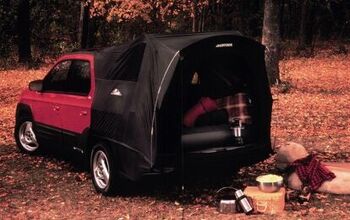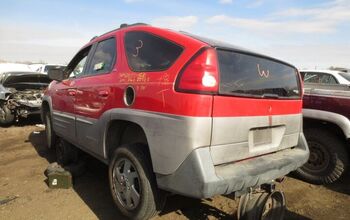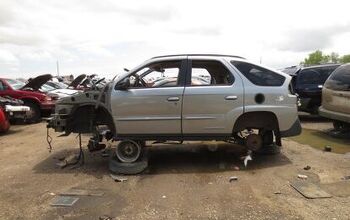In Defense Of: The Pontiac Aztek
Automotive history is littered with titanic failures. For every hot-selling Mustang, there’s a hatful (hateful?) of Vegas, Pintos, Excels, Yugos, Edsels and, of course, Azteks. From its introduction until its timely demise some four years later, the Pontiac Aztek SUV was the subject of journalistic dog-piling and a thousand weak jokes. But really, does it belong in this infamous company? The answer is a bit complicated; the Aztek was certainly a failure, but not exactly in the way you might expect.
First, let’s look at the Aztek’s indisputable failure: sales. Pontiac aimed to sell 75k Azteks a year. In its first model year (2001), GM shipped less than 10k Azteks to private buyers, dumped quite a few thousand on unfortunate middle-managers and sent the rest to the rental fleets. After an emergency re-style, a price-cut and deep discounts, sales climbed to around 25 – 27k units per year, and stayed there until the car’s demise.
The Aztek may have been a car lot pariah, but it was no Chevy Vega. There were no major recalls or horror stories involving melting engines. The model was as reliable as any GM vehicle of its time, cutting edge in many ways (CAD-CAM designed, red light dash, optional heads-up display), outdoorsy (could be converted into a camper, complete with built-in air compressor for your air mattress), lifestyle-oriented (racks for bikes, canoes, kayaks, etc.) and beloved (high scores on “CSI" owner surveys). Despite abuse from all quarters, the Aztek earned itself a group of passionate devotees.
Even so, it bombed. So who exactly gets the blame for this so-called fiasco? Again, there's no denying that the engineers didn’t make it pretty, but they made it well. The UAW also gets a pass; GM built the Aztek (and Buick Rendezvous) in Mexico’s Ramos Arizpe plant. No, the blame lies squarely on the shoulders of GM's bean counters. That’s because the Aztek’s biggest problem wasn’t its confused looks (though they didn’t help). It was price.
The Aztek was designed for younger couples and families who didn’t want a great honking SUV. Pontiac priced the Aztek in the region of $25k to $30k. Unfortunately, the price was well into premium minivan and three-row SUV territory. The Aztek offered Versatrak all-wheel drive and a lot (a LOT) of cladding, but it fooled no one. The vehicle its makers labeled “quite possibly the most versatile vehicle on the planet” was priced at least $5k above its logical, non-SUV competition.
Given that most of the Aztek’s technology was off-the-shelf, and south-of-the-UAW labor costs were low, why was the initial asking price so high? When the Aztek was designed, Pontiac had no high profit SUV’s. When their line finally got an SUV (ok, a proto-crossover), Pontiac’s brass were hungry for big profit margins, despite the fact that the Aztek was a more-expensive unitary design. So GM cut production costs as deeply as possible and then set the retail price to deliver big profits while still undercutting Chevy’s mid-sized SUVs (Trailblazer). Great in theory, poison in practice.
Even so, why did GM/Pontiac think they could sell 75k Azteks? Of course, missing a sales target is hardly a novelty in the car industry, especially at General Motors. Even though the domestic automaker pays thousands of researchers huge amounts of money to find out how many people want (or think they want) what, no one has quite cracked that particular nut. The market research leading to the Aztek is locked away, deep inside GM's vaults. Did they ask the wrong questions, or simply draw the wrong conclusions?
GM certainly was on to something with the Aztek's manufacturing system. Like Honda's Odyssey/Ridgeline twins, the Mexican plant could switch between Azteks and Rendezvous. Unfortunately, there wasn't enough demand for either vehicle to make the so-called "flexible" system work. In fact, GM has had some terrible luck with plants capable of making limited production runs, such as the now-closed Lansing facility (Reatta, EV1, SSR). As a result, the majority of GM's business is still built on big runs, with the “extra” (i.e. surplus to retail demand) units going to fleets. The company is still not set up to profit on small volumes for niche markets. Which is exactly what today's fragmenting market demands.
Now that it’s gone, many want to write off the Aztek as one of the great all-time automotive disasters. On the face of it (should you be able to look), it was. But in many important ways, it wasn’t. Again, the model broke new ground in many areas. The epitaph should not be “GM’s Edsel”. Or maybe it should. Edsel Ford was hounded by his famous father and ruined by the stress of holding a disintegrating company together. The Aztek died because it was forced to carry the hopes and dreams of an entire division, when it was just a decent, homely little people-carrier.
More by Andrew Dederer
Latest Car Reviews
Read moreLatest Product Reviews
Read moreRecent Comments
- Theflyersfan OK, I'm going to stretch the words "positive change" to the breaking point here, but there might be some positive change going on with the beaver grille here. This picture was at Car and Driver. You'll notice that the grille now dives into a larger lower air intake instead of really standing out in a sea of plastic. In darker colors like this blue, it somewhat conceals the absolute obscene amount of real estate this unneeded monstrosity of a failed styling attempt takes up. The Euro front plate might be hiding some sins as well. You be the judge.
- Theflyersfan I know given the body style they'll sell dozens, but for those of us who grew up wanting a nice Prelude Si with 4WS but our student budgets said no way, it'd be interesting to see if Honda can persuade GenX-ers to open their wallets for one. Civic Type-R powertrain in a coupe body style? Mild hybrid if they have to? The holy grail will still be if Honda gives the ultimate middle finger towards all things EV and hybrid, hides a few engineers in the basement away from spy cameras and leaks, comes up with a limited run of 9,000 rpm engines and gives us the last gasp of the S2000 once again. A send off to remind us of when once they screamed before everything sounds like a whirring appliance.
- Jeff Nice concept car. One can only dream.
- Funky D The problem is not exclusively the cost of the vehicle. The problem is that there are too few use cases for BEVs that couldn't be done by a plug-in hybrid, with the latter having the ability to do long-range trips without requiring lengthy recharging and being better able to function in really cold climates.In our particular case, a plug-in hybrid would run in all electric mode for the vast majority of the miles we would drive on a regular basis. It would also charge faster and the battery replacement should be less expensive than its BEV counterpart.So the answer for me is a polite, but firm NO.
- 3SpeedAutomatic 2012 Ford Escape V6 FWD at 147k miles:Just went thru a heavy maintenance cycle: full brake job with rotors and drums, replace top & bottom radiator hoses, radiator flush, transmission flush, replace valve cover gaskets (still leaks oil, but not as bad as before), & fan belt. Also, #4 fuel injector locked up. About $4.5k spread over 19 months. Sole means of transportation, so don't mind spending the money for reliability. Was going to replace prior to the above maintenance cycle, but COVID screwed up the market ( $4k markup over sticker including $400 for nitrogen in the tires), so bit the bullet. Now serious about replacing, but waiting for used and/or new car prices to fall a bit more. Have my eye on a particular SUV. Last I checked, had a $2.5k discount with great interest rate (better than my CU) for financing. Will keep on driving Escape as long as A/C works. 🚗🚗🚗





































Comments
Join the conversation
It's very entertaining to read this article almost 5 years after it was published. Most of what I read here is the same stuff that I heard back when the car was still on sale, it's ugly. Very few folks ever criticized anything else about the car, although outside of the styling, it was pretty conventional. We had a 2001 1SC and a 2004 Rally. For whatever reason, my wife loved them. Of course, at that time, we had two young children and we did all of the soccer, scouts, church camps, etc., and this car was great for that kind of thing. At first I was put off by the styling and the fact that it was a little less functional than a minivan (which is what I wanted). But it was functional in other ways I hadn't expected. Not having sliding doors wasn't that big of a deal and the two piece hatch had some advantages. The 2001 had some reliability issues intially, but were resolved by our Pontiac dealer quickly. The dealer gave us a very sweet lease deal on this car. During the time we had the 2001, the dealer was purchased by a mega dealer and the level of service changed, no longer as friendly as the original dealer. In 2003, my wife saw pic of the 2004 Rally and decided to get one. I was OK with this, as the 2001 beyond the initial teething issues, was rock solid. We got a 2004 Rally like the ones in the pictures in this posting. The 2004 had all of the 3.4 V6 issues along with all of the wheel bearing and a/c issues the U body is known for. The deal breaker for me was the catastrophic failure of the torque converter. I no longer trusted the orange Aztek and we traded it for a Malibu Maxx in 2006. So, 5 years later, and I can see the end of days coming for my daily driver. One of the potential cars on my replacement list is an Aztek. Why? Even with all of the stuff I know about them, I have not driven a car with the same kind of utility for the size footprint that car has. It's big enough not to be cramped, but not so large as to be a liability in downtown parking situations. (I work in a downtown location, sometimes street parking is my only choice) The fuel mileage is not punitive, and it will carry most everything I need. The problem is, now these are pretty old cars, I don't know if I want to spend the time troubleshooting one to make it a daily driver. I may have to go with my second choice, another Malibu Maxx...
Unfortunately, my wife and I no longer have a love of this vehicle. We finally had enough after $10K in repair costs between 2004 and 2010 on our 2003. Leaked oil directly off the lot, and took three repair sessions to fix. Blew head gaskets TWICE, once directly after having the transmission replaced in 2010. Bad rocker arm issues, and then had constant overheating issues. We loved it for its versatility, but hated it for the huge hole it dug in our wallets. Our 2008 Highlander has been MUCH more reliable.